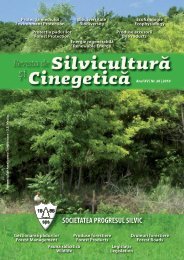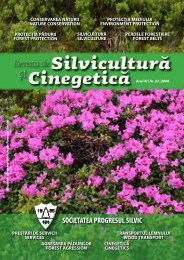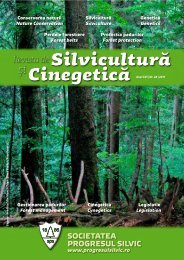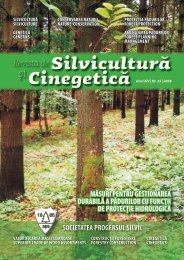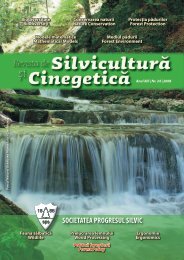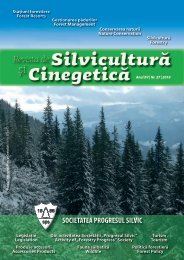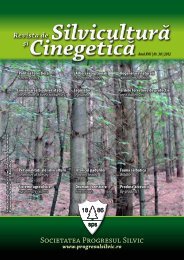Silviculture and Cinegetics Review - Societatea Progresul Silvic
Silviculture and Cinegetics Review - Societatea Progresul Silvic
Silviculture and Cinegetics Review - Societatea Progresul Silvic
You also want an ePaper? Increase the reach of your titles
YUMPU automatically turns print PDFs into web optimized ePapers that Google loves.
FORESTRY BELTS SILVICULTURE AND CINEGETIC REVIEW XVII/30/2012<br />
The increasing development of tourism raises<br />
particular problems to forestry vegetation along traffic<br />
routes, being called to contribute to the radical<br />
improvement of l<strong>and</strong>scape given by each passageway<br />
from an aesthetic <strong>and</strong> touristic point of view. Because,<br />
man spends many hours a day on various roads, these<br />
should meet the requirements not only of modern<br />
technology but also of spiritual dem<strong>and</strong>s of the driver.<br />
From here a new concept "the road must serve first<br />
the man <strong>and</strong> then the car." Roads must help man to<br />
know nature. In addition, forest vegetation along the<br />
passageways must ensure masking different<br />
unpleasant looking places (deposits of various<br />
materials, ab<strong>and</strong>oned construction debris etc) dressing<br />
the slopes of bridges embankments at crossings (see<br />
bridges of the A -1) etc. It is necessary to pursue<br />
enrichment <strong>and</strong> emphasizing edge contours, creating<br />
beautiful compositions, greater choice of colors to<br />
eliminate monotonous appearance of outskirts.<br />
Hence the need for foresters to broaden concerns in<br />
planting along traffic routes (both auto <strong>and</strong> rail),<br />
giving more attention to the choice of species for<br />
snow protection forest belts by considering: foliage<br />
appearance, manner of branching, size, resistance to<br />
blizzard (including to snow breaks), melliferous<br />
potential, fruit production, therapeutic products, etc.<br />
It should be noted that these issues were considered<br />
by our predecessors, for example I.Z. Lupe since 1952<br />
recommended the introduction of melliferous <strong>and</strong> fruit<br />
species among marginal rows of forest belts.<br />
5. Preparing ground for planting forest<br />
snow protection forest belts<br />
All authors referred to, without exception, recommend<br />
careful preparation of the ground before planting,<br />
preparation which must be all the more thorough with<br />
how much vegetation conditions, general of the area<br />
<strong>and</strong> particular of the planted section, are more<br />
difficult. The need for a proper preparation was<br />
underlined since 1937 C.D. Chiriţă <strong>and</strong> M.Petcuţ, <strong>and</strong><br />
I.Z. Lupe (1952) considers preparing the ground<br />
before planting as a base operation on which depends<br />
the success <strong>and</strong> further development of the forest belt.<br />
He believes that the preparation technique depends on<br />
the ground configuration, its condition before the<br />
work starts, on previous usage <strong>and</strong> it recommends:<br />
I – on ab<strong>and</strong>oned l<strong>and</strong>, fallow l<strong>and</strong>, leashes with<br />
brush, pastures, l<strong>and</strong> invaded by weeds, l<strong>and</strong> occupied<br />
by ancient forest cultures in a very advanced state of<br />
degradation:<br />
- cleaning ground of weeds, brush, wild sprouts etc;<br />
- clearing with plow if necessary;<br />
- deep-plowing (without removing the surface<br />
carbonates when present);<br />
-heavy harrowing with the heavy harrow;<br />
-black field in summer (July-August) with repeated<br />
harrowing, which will bring to the surface residue <strong>and</strong><br />
roots of weeds to be destroyed by heat; weed seeds<br />
left in the ground will germinate towards fall but will<br />
not start to fructify <strong>and</strong> will be destroyed by deep<br />
plowing in fall;<br />
- in fall, deep plowing (35-40 cm) with plow with<br />
jointer.<br />
In the absence of weeds black field is no longer<br />
necessary, after removal of brush <strong>and</strong> grubbing,<br />
passing to plowing in fall.<br />
II – on l<strong>and</strong> with a lot of couch-grass:<br />
- agricultural crops for 1-2 years, followed by 1 year<br />
black field (both for destruction of weeds <strong>and</strong> for<br />
accumulation of moisture in the soil).<br />
III – on destructured, dusty l<strong>and</strong>:<br />
- 2-3 years with mixed cultivation of legumes <strong>and</strong><br />
perennial grasses (70-30/100 proportion)<br />
-cultivation for a year of 2-3 rows on each side of the<br />
future forest belt with high agricultural plants (corn,<br />
sunflower, etc.) whose stems are not cut during the<br />
winter (for both snow accumulation to increase<br />
reserve of soil humidity <strong>and</strong> to reduce the danger of<br />
snow accumulation of the passageway until planting<br />
the forest belt;<br />
- drawing on both sides of the future forest belt of 2-3<br />
deep overlapping furrows, for additional accumulation<br />
of moisture for the future forest belt (the accumulation<br />
of snow in the ditches) <strong>and</strong> as a protection measure for<br />
the forest belt;<br />
- deep autumn plowing, desirable with plow for great<br />
depths (50 cm.).<br />
In all instances care should be taken in the case of pest<br />
infestation of the ground (larvae of beetles, etc.).<br />
6. Maintenance of snow protection<br />
forest belts<br />
It should be noted first that the maintenance of forest<br />
belts after planting is not confined to mobilizing the<br />
soil a certain number of years. Thus, the same Lupe<br />
recommends cultivation on spaces between rows, for<br />
2-3 years after planting, of 2-3 rows of large<br />
agricultural plants to reduce the influence of dry<br />
winds on the development of seedlings <strong>and</strong> to protect<br />
the passageway until the start of the functionality of<br />
the forest belt. In case of manual planting, the same<br />
32



